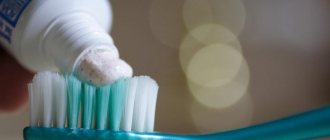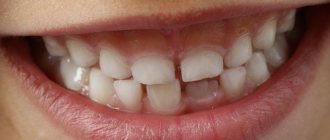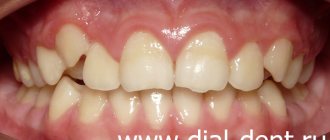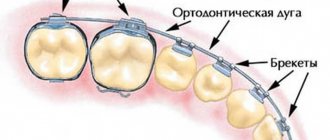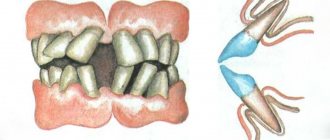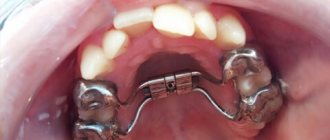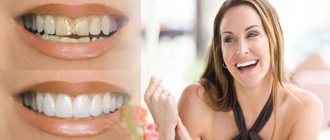Sometimes, after installing braces, a person notices that his teeth have become too mobile. Many people begin to panic and go to the dentist to remove the orthodontic appliance. But in most cases, tooth mobility is normal. In this article we will tell you why teeth become loose after braces and what needs to be done.
In this article
- Changes in the mouth while wearing braces
- Why are teeth loose?
- Why do teeth wobble under braces from an anatomical point of view?
- What to do if teeth become loose under braces?
- Why do you need retainers for loose teeth?
- In what cases is loose teeth not normal?
- Proper care will protect against loose teeth
Changes in the mouth while wearing braces
Installing a brace system to correct a bite or straighten teeth is almost always accompanied by an adaptation period. In some patients it can be several days, in others - a couple of weeks, it depends on the individual characteristics of the body. During the adaptation period, elements of the orthodontic structure can rub the mucous membrane, lead to the formation of ulcers on the inside of the lips and cheeks, and cause discomfort. Patients are warned about possible temporary disturbances in diction and difficulties in pronouncing certain sounds.
But practice shows that many are not prepared for the loosening of their teeth while wearing braces. If a tooth is loose under braces, there is a fear of losing it. Is it really possible to lose loose teeth on which braces are attached? In most cases, unusual mobility is normal and, as long as your dentist recommends it, will not lead to tooth loss.
When mobility occurs after fixation of the system
After installation of the system, the patient experiences unpleasant pulling sensations caused by the pressure of the arc. When wearing braces, slight mobility of individual elements is a completely normal and natural phenomenon. Answering the question of why teeth can become mobile during orthodontic treatment, experts in the field of orthodontics explain that this is due to the peculiarities of the anatomical structure of the dentofacial system.
After installing the braces system, you may feel the teeth move
Incisors, canines and molars are attached to the jawbone by elastic ligaments surrounded by dense connective tissue. The impact of the structure leads to displacement of elements, which reduces tissue density and disrupts the stability of the teeth. The following are signs that the correction is going well:
- slight mobility of elements,
- looseness is observed in the first days after fixation of the structure and persists throughout the entire orthodontic course,
- gums look healthy, there are no signs of inflammation,
- There is no acute piercing pain, and moderate discomfort is not a symptom of pathology.
“I was also scared when I noticed that my teeth had become mobile. But it showed up for me probably a month later. When I pressed a little with my fingers, I clearly felt them wobbling. Not much, but still. I was very scared. But the orthodontist left me her mobile number just in case. I called her immediately, and she calmed me down. There is nothing like that here, that's normal. Of course, if you are very unsteady, it is better to go straight to the doctor. But in my case they became only slightly mobile.”
Vika777, from correspondence on the 32top.ru forum
In most cases, this is normal if there is some mobility. But if you have doubts about the condition of your teeth and gums, seek advice from a specialist. It is better to make sure once again that nothing threatens the health of the oral cavity than to start a pathological process and bring the situation to irreversible consequences.
Why are teeth loose?
To understand the reason why a tooth is loose, you need to know how the braces system works and how it works. The design of the bracket system is such that a small lock is attached to each tooth according to a certain pattern. An orthodontic arch made of shape memory material is installed in the fastenings of each lock. This arch puts pressure on the dentition and promotes tooth movement.
What causes the displacement? Under the influence of a directed load, the bone tissue on one side decreases, the tooth socket expands, which allows the tooth to move to a new location. At the same time, in order for him to sit firmly in a new place, on the other hand, the bone tissue must grow, this process takes time. During the period when the socket has already widened, and not enough new bone tissue has grown, the teeth can be mobile. That is, their mobility during the period of movement is the norm, which should not frighten. The main thing is to fix the tooth in its new place in the jawbone after displacement.
Folk remedies to prevent loosening
The right thing to do if you notice problems with your braces is to visit an orthodontist. But, if there is a lot of time left before the visit, you can help yourself with some folk remedies. Various herbs and home remedies are used for this, but toothpaste is the best one.
You should squeeze the paste onto your toothbrush as if you were brushing your teeth normally and drop some essential oil on it (one drop will be enough). It is a natural antiseptic that is often used to protect gums from inflammation. You should brush your teeth with this solution at least twice a day.
Let's look at other folk tricks:
- Licorice root reduces plaque formation on teeth;
- Massaging the gums using turmeric, black pepper and alum helps a lot;
- Blueberry roots and hawthorn berries significantly strengthen teeth.
Why do teeth wobble under braces from an anatomical point of view?
Teeth are made up of two main parts—the dental crown (the visible part) and the root. They are connected to each other by a ligament supported by bone tissue. Under the pressure of braces, the tooth tilts, as a result of which the distance between the ligament and the dental crown changes: on the one hand it becomes larger, and on the other, on the contrary, smaller. Special cells - osteoblasts - begin to actively work and restore the missing bone tissue to create a new support for the tooth. Other cells—osteoclasts—perform the opposite job: they promote the resorption of bone tissue where the tooth needs to be moved.
In this way, the pinched connective ligament gradually straightens out, and the tooth can take its correct position. Such cycles of loss and growth of bone tissue are repeated many times during orthodontic correction, contributing to the gradual correction of the dentition.
But the speed of these processes is different: bone tissue is absorbed faster than it grows. This is the main reason why teeth become loose after braces start working.
The archwire flew out of the bracket, what should I do?
- Most often, thin wires used at the beginning of treatment fly out of the last braces. Experienced orthodontists know how to minimize such phenomena. In particular, the arch can be bent behind the last bracket; in addition, thin arches are often placed only up to the sixth teeth, since they often fly out of the tubes on the seventh teeth. If this trouble nevertheless happens to you, try in front of a mirror using tweezers or nail clippers (just don’t bite off the arch!) to tuck the arch into the tube on the last tooth: this manipulation is akin to threading a thread through the eye of a needle. If you can’t do it or you don’t want to acquire new skills, then contact your orthodontist, he will quickly fix the problem.
- The arch can also shift due to low friction in the system (primarily applies to self-ligating braces). In this case, the archwire protrudes from one side and slides out of the last bracket on the other side. This happens because the orthodontist either forgot to fix the stoppers on the arch, or they turned out to be ineffective for one reason or another. The problem is resolved in the same way as the first point.
- When closing gaps or correcting crowding of teeth, the length of the dentition decreases, but the length of the arch remains the same, respectively, an excess of the arch appears behind the last braces. If the tip of the arch is large enough and pricks your cheek, then visit your orthodontist (by prior arrangement, of course), he will remove the excess arch in a couple of minutes. If the tips of the arch are visible, but do not seriously bother you, then do not worry and come to the next scheduled appointment, because this is a sign of progress in correcting the bite.
What to do if teeth become loose under braces?
First of all, you need to contact an orthodontist and make sure that the loosening process is physiological and does not threaten the teeth. If the doctor confirms that everything is in order, then you just need to follow the dentist’s recommendations. In particular, reduce the load on the teeth:
- temporarily avoid solid foods (carrots, apples, nuts, caramels, seeds);
- exclude chewing gum, toffees, corn flakes, dried fruits and other foods that stick to the teeth;
- do not bite nails or pencils;
- follow a “soft” diet, which includes mainly liquid and puree dishes (porridge, pates, smoothies, vegetable and fruit purees).
Following these recommendations will not only prevent the loss of mobile teeth, but will also protect the braces from damage. For accelerated bone tissue regeneration, it is important that the diet contains protein products and a full range of essential minerals and vitamins.
Why do you need retainers for loose teeth?
After removing the braces, in most cases it is necessary to wear a special orthodontic mouthguard, or retainer. Its main function is to fix and hold the teeth in the correct position until the process of regeneration of new bone tissue is completely completed. If you neglect to wear a retainer, your teeth may return to their original place after the braces are removed.
The retention period when it is necessary to wear a mouth guard lasts approximately 2 times longer than the period of wearing braces. On average it is 3-4 years. During this time, the process of bone tissue restoration should be completely completed, the teeth will completely stop loosening and will remain securely in their new place.
In what cases is loose teeth not normal?
Rarely, there are situations when the cause of tooth loosening is not in the physiological process of resorption and growth of bone tissue, but in some kind of disease.
For example, teeth may become loose if a patient develops osteomyelitis or osteoporosis. Also a common cause of pathological loosening is periodontal disease in the acute stage. Teeth become mobile due to gingivitis, periodontal disease, and periodontitis.
And if bone pathologies arise on their own, then periodontal diseases are most often caused by insufficient hygienic oral care and braces.
In any case, to exclude pathology of the bones or gums, at the first sign of loose teeth, you should consult a dentist. The doctor will conduct a full diagnosis, determine why the teeth are loose and, depending on the results of the examination, prescribe treatment or give recommendations.
Causes of loosening
Braces systems are used to correct anatomical defects of the jaw. The base is installed on each tooth, after which it is fixed with arches. It is assumed that under the influence of this design the row will shift in a given direction.
The cause of loosening when wearing an orthodontic structure may be a physiological reaction or a pathological process. You will not be able to determine on your own what caused the problem. You should definitely see a dentist and get individual recommendations.
When it's ok
Teeth are considered the most functional skeletal system in the human body. Therefore, dentists can easily adjust their position and correct anatomical defects. While wearing the corrective system, the incisors and canines naturally become loose. This process is caused by the interaction of osteoclasts and osteoblasts.
- The base of the bracket is securely attached to the enamel. Each unit is fixed to each other using a metal arc. Under the influence of tension and pressure, a gradual displacement of the incorrectly positioned tooth occurs.
- When displaced, the space between the root and the jaw bone increases. Because of this, the patient may notice slight loosening. Over time, young bone tissue cells are formed in this zone, synthesizing the intercellular matrix - osteoblasts. The resulting empty space is filled with new structures.
- The shifting root requires new space to change position. If on one side it appears and is filled with a new matrix, then on the other it should disappear. This process is supported by osteoclasts - giant multinucleated cells that destroy excess layers of bone tissue.
Important!
The balance of osteoblasts and osteoclasts is controlled by the human body. Most often, the resorption of bone tissue occurs quickly, and the growth of new tissue occurs slowly. Therefore, for a long time, the incisors and canines become loose after the braces are removed. To correct this consequence, retainers are used.
When to worry
It cannot be stated unequivocally that teeth cannot fall out due to braces. Sometimes pathological processes lead to the loss of incisors and canines (less commonly, premolars and molars). Therefore, you should always worry about loosening, but not in all cases the alarm will be justified.
The cause of complaints may be pathological processes. These include periodontitis, gingivitis, periodontal disease. Signs that the patient has problems:
- increased bleeding of gums;
- reduction of gingival papillae;
- root exposure;
- painful sensations when biting and chewing food;
- swelling and redness of the gums;
- itching;
- increased body temperature;
- headache;
- suppuration of the gum pocket.
Proper care will protect against loose teeth
One of the causes of loose teeth is periodontal tissue disease. To prevent their development, you need to properly care for your mouth while wearing an orthodontic appliance.
Proper care involves daily brushing of teeth with 3-4 types of brushes - regular, special orthodontic with a V-shaped bristle, single-tuft and brush-brush. These devices are used alternately, gradually removing all dirt and plaque. After brushing your teeth, you need to clean the interdental spaces using superfloss - a special orthodontic dental floss. At the final stage, the oral cavity and the braces system are cleaned using an irrigator. This device directs a powerful stream of water, which removes dirt from interdental spaces, periodontal pockets and other difficult areas. To care for braces, it is important to purchase irrigators with special orthodontic attachments.
Careful and regular oral care will prevent pathological loosening of teeth under braces and avoid their loss.


